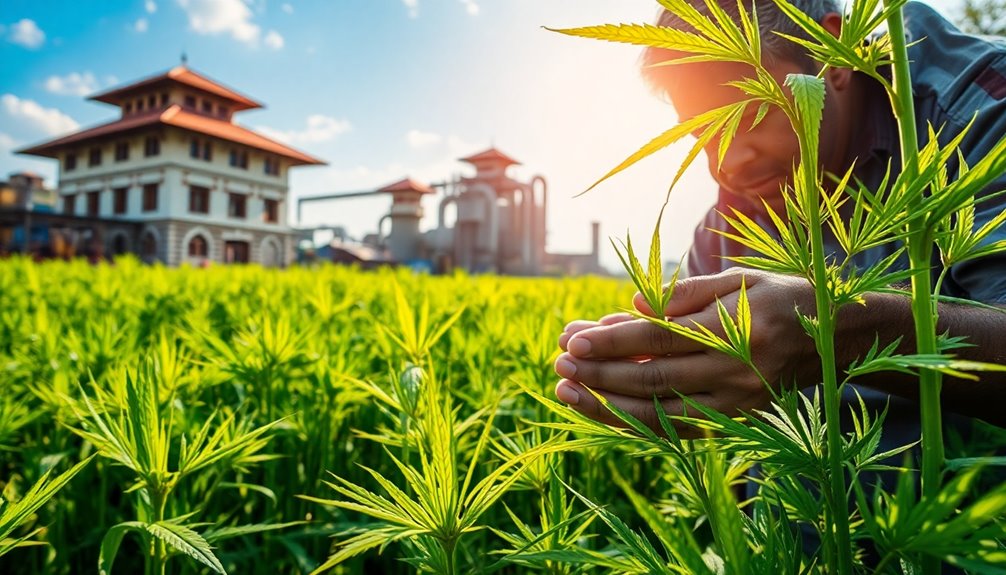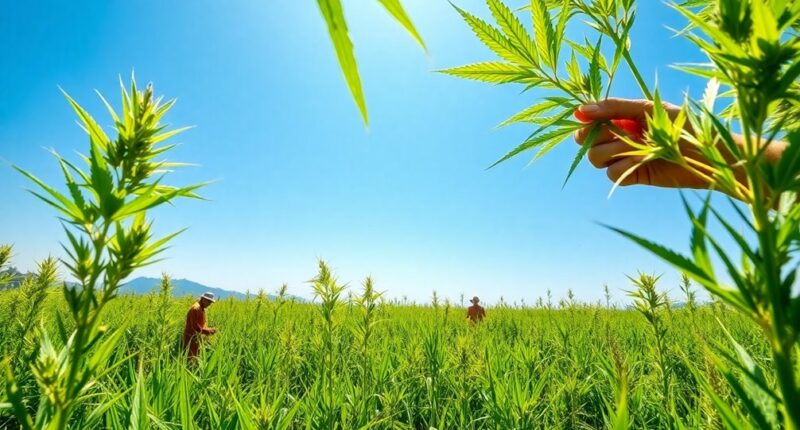Industrial hemp in Nepal shows promising production trends, particularly in rural areas where traditional cultivation practices thrive. Local communities are increasingly interested in hemp products, especially as global demand for sustainable options rises. However, legal barriers and economic challenges hinder growth. Despite these hurdles, hemp has the potential to create jobs and stabilize income for families. If you're curious about the specific opportunities and future prospects for hemp, there's more to explore.
Key Takeaways
- Traditional hemp production practices in rural Nepal are labor-intensive, relying on co-harvesting with other crops like wheat and maize.
- Rising local interest in hemp products among youth and tourists indicates a growing market potential for sustainable goods.
- Legal reforms are necessary to clarify regulations and unlock the economic potential of industrial hemp cultivation in Nepal.
- Global demand for sustainable products presents significant export opportunities for Nepal's hemp industry, enhancing economic stability.
- Investing in hemp could create jobs and promote environmental sustainability, leveraging its historical significance for future growth.

Industrial Hemp in Nepal
Although industrial hemp has a rich history in Nepal, its potential remains largely untapped due to complex legal issues. You might be surprised to learn that hemp fiber has been a staple in Nepal for generations, valued for its strength and durability. Despite this, hemp cultivation was banned in 1973, primarily due to confusion with marijuana.
Today, while using hemp as a medicinal herb is legal, cultivating it for industrial purposes is technically illegal. This leaves many rural communities relying on wild growths for harvest.
If you venture into western Nepal, particularly in districts like Darchula, Rolpa, or Bajhang, you'd see traditional methods still in practice for producing hemp. Farmers often co-harvest hemp with grains like wheat and maize, but the remote nature of these regions makes transportation a challenge.
You'd likely notice locals manually processing the fibers, a labor-intensive task that results in products such as bags, ropes, and traditional clothing. Yet, for finer products, many still depend on imports from countries like China. Ganesh's operations include approximately 95% of the workforce being female, which empowers women in these communities. Additionally, investing in hemp could provide a hedge against currency devaluation, enhancing economic stability in these regions.
The economic impact of hemp in these areas is significant. It provides a much-needed source of income for communities with limited employment opportunities. Despite existing export policies, challenges like transportation costs and the lack of government incentives hinder growth.
You'd see that there's a rising local interest in hemp products, especially among youths and tourists who appreciate their sustainability and durability.
As you explore the market, you'll observe that hemp bags are becoming increasingly popular, with prices ranging from Rs600 to Rs5,000 based on quality. The global demand for sustainable products presents an opportunity for Nepal to cultivate industrial hemp legally.
Embracing this could lead to job creation, economic development, and environmental sustainability, allowing communities to thrive. With the right advocacy and support, the future of industrial hemp in Nepal could be quite promising.
Frequently Asked Questions
What Are the Legal Regulations for Growing Industrial Hemp in Nepal?
In Nepal, growing industrial hemp is technically illegal, but it's often tolerated for traditional uses.
The Narcotic Drugs Control Act prohibits cultivation unless you have a government license. You might see exemptions for medical or scientific purposes if you obtain a special permit.
There's a proposed Cannabis Cultivation Act aiming to regulate hemp with a THC limit of 0.2%, easing some barriers for farmers interested in this crop.
How Does Industrial Hemp Benefit the Environment?
Imagine a farmer planting hemp instead of traditional crops.
You'd notice how hemp captures carbon dioxide, significantly reducing greenhouse gases. Plus, it grows without pesticides, making your fields safer and healthier.
Its deep roots prevent soil erosion, restoring land degraded by other farming practices. As it absorbs heavy metals, hemp cleans up contaminated soils, benefiting not just your farm but the entire ecosystem.
What Are the Key Markets for Hemp Products in Nepal?
In Nepal, the key markets for hemp products include the domestic sector and international exports.
You'll find a growing demand among youths for durable, eco-friendly hemp bags, as well as clothing and accessories. Small and medium enterprises play a significant role in this market.
On the export side, countries like the US, Europe, Canada, and Australia present opportunities, driven by the global interest in sustainable products.
How Can Farmers Access Seeds and Resources for Hemp Cultivation?
Imagine standing in a field of green, where hemp plants sway gently in the breeze.
To cultivate this crop, you'll need access to seeds and resources currently hindered by legal barriers.
While wild plants provide some fiber, you're stuck without commercially available seeds.
If regulations change, you could source quality seeds and modern farming techniques, transforming your harvest into a sustainable income source, allowing you to embrace the potential of hemp cultivation fully.
What Challenges Do Farmers Face When Growing Industrial Hemp?
When you grow industrial hemp, you face several challenges.
First, sourcing quality seeds can be tough, and managing weeds and pests without the right tools complicates things.
You might also struggle with the steep hills and varying altitudes that affect growth.
Additionally, the stigma surrounding hemp can hinder support from your community.
Without proper knowledge and resources, navigating these obstacles becomes even harder, limiting your potential for success in the hemp market.
Conclusion
As you explore the production trends and valorization opportunities for industrial hemp in Nepal, you can't help but see the contrast between its untapped potential and the challenges that lie ahead. While the plant thrives in the fertile soil of the Himalayas, regulatory hurdles and market limitations stifle its growth. Yet, with every hurdle comes the chance for innovation and change. Embracing hemp could transform not just the economy, but also the environment, making it a beacon of hope for Nepal's future.









